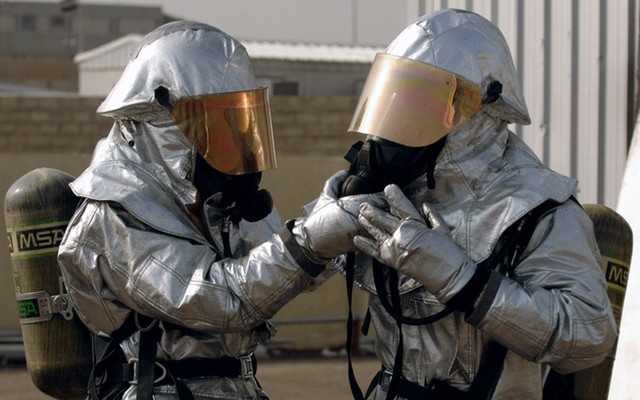
Confined space entry training is required if you will be working in potentially hazardous areas not originally intended for human occupancy. In Part 4 of our Fundamental Guide to Confined Space Entry Training, you will learn why this course matters so much, and the hazards you need to be aware of before entering. When it comes time for you to register for training, trust the experienced professionals at ACUTE Environmental and Safety Services to keep you safe on the job. Contact us or sign up for our confined space entry training today.
Confined Space Entry Training – Fundamental Guide: Part 4
To get caught up before reading on: Part 1 of our Fundamental Guide to Confined Space Entry Training outlined the relevant rules and regulations; in Part 2, you learned who needs to take this course; and in Part 3, you read about exactly what you will learn during the course.
Why Confined Space Entry Training Matters
As a reminder, and according to the Government of Canada, “confined space” is defined as the following:
- Not designed or intended for human occupancy except for the purpose of performing work;
- Has restricted means of access and egress; and
- May become hazardous to an employee entering it due to
- its design, construction, location or atmosphere,
- the materials or substances in it, or
- any other conditions relating to it.
Examples of confined spaces include manholes, sewers, boilers, tunnels, pipelines, wells, fuel tanks, ballast tanks, storage tanks, tank cars and tank trucks, vats, process vessels, septic tanks, sewage lift stations, silos, boots in grain elevators, trenches, or ventilation and exhaust ducts.
Read on to discover the three main dangers in confined spaces and you should also check out our previous article on The Essential Elements of Confined Space Safety.

Studies indicate that accidents are caused when you are not well trained or fully informed about the hazards of entering confined spaces.
1. Oxygen Deficiency and Enrichment
Many deaths in confined spaces are caused by a lack of oxygen. There are two main causes of oxygen deficiency, according to the federal government:
- Oxygen is displaced by gases such as nitrogen, an inert gas introduced to displace flammable gases when purging vessels in preparation for hot work.
- Oxygen is used up by:
- combustion of flammable substances such as in welding and other hot work;
- explosions or fires (oxygen levels may stay dangerously low long after the fire is out because the oxygen is replaced by the products of combustion);
- chemical reactions such as rusting of metal;
- people working in the space and using up oxygen as they breathe.
The normal air you breath contains approximately 21% oxygen by volume at normal atmospheric pressure. At 16% oxygen, your judgment and breathing become impaired and you will become quickly exhausted. At 12%, you will fall unconscious and will die unless removed to fresh air. At 6%, you have difficulty breathing and will die in seconds.
On the flip side, oxygen-enriched atmosphere means more than 23% oxygen by volume. This will cause flammable materials, such as clothing and hair, to burn violently when ignited.
For more, read The Science Behind The Hazards Of Confined Spaces.

Confined space entry training will teach you to make sure oxygen levels have been tested fully before you enter.
2. Toxicity
Toxic (poisonous) gases commonly present you with two kinds of risk in a confined space:
- Chemical asphyxiation (smothering);
- Irritation to the respiratory system, the skin and eyes.
Toxicity occurs when the confined space you are working in contains toxic gasses such as:
- Hydrogen Sulfide
- Methane
- Ammonia
- Carbon Dioxide
- Carbon Monoxide
Gasses such as carbon monoxide, are odourless and colourless – meaning you could quickly find yourself in a carbon monoxide-filled environment without even knowing it. Carbon monoxide is highly toxic and can become lethal in extremely small doses – sometimes less than a 1% saturation can cause death.
Other gasses, such as the gasses found in storage silos, do have an odour or colour. Some gasses may look red, brown, or yellow-tinged. If you are working on a farm and notice a gas with colour, it is advised that you do not enter the confined space for at least 6 weeks to ensure the gas has properly cleared.
Hydrogen sulfide has a strong smell, similar to rotten eggs. However, in high doses, it can actually block your sense of smell – making it difficult to detect. It can also become lethal within seconds. It’s important to always test for gasses along the way and at different levels.
Employers should also provide workers with information on dealing with toxic gasses and provide appropriate equipment.

You will learn to test carefully for toxicity in confined space entry training.
Drowning in Liquids / Entrapment in Free-Flowing Solids
Flowing liquids are generally an observable issue within a confined space. However, that is not always the case, as a new area or level may contain liquids that previous levels did not. Some examples are:
- Water in a tank
- Grain in a silo
- Earth falling into a trench or excavation
Flowing liquids can become a serious problem as workers may drown or become trapped. Some fluid solids, such as grain, can also drown workers. Silos are extremely dangerous as grain can act in a similar way to quicksand, sucking a worker in without any means of escape.

All free-flowing liquids and solids should be removed before you enter a confined space.
In sum, confined space entry training will teach you more about these potential hazards, as well as this handy rule of thumb:
If you can’t test,
If you can’t ventilate,
If you don’t have a breathing apparatus,
If you don’t have an entry procedure,
Don’t go in!
Need Confined Space Entry Training? Trust ACUTE!
Hands-on, practical confined space training is the best way to keep employers and workers safe in the workplace! ACUTE is dedicated to workplace safety and understands the importance of course and training provider approval. Why get workplace safety training with ACUTE? Here are just some of the benefits of working with ACUTE.

- Open Door Instructor-Student Partnership – ACUTE’s training services emphasize client participation. Staff foster relationships with clients and serve as a touchstone for advice anytime moving forward.
- Serving Your Team and Industry – With a vast array of clients in manufacturing, construction, health, academic, and government sectors, ACUTE brings the best safety practices from across the spectrum to your workplace.
- 100 Years Combined Experience – ACUTE provides comprehensive health and safety training, on-site safety services, and consulting services. With over 100 years of combined experience, our company staff offer more than theoretical or abstract ideas. ACUTE offers solutions.
- Track Record of Success – ACUTE is rated 4.9/5 stars on Google reviews, demonstrating a commitment to our clients, quality, and passion for training.
“We have relied on ACUTE for years to train our staff and keep them safe on the job site.”
– Bob, Millwrighting Company
ACUTE is located in Waterloo, Ontario, and services customers from cities such as Toronto, Mississauga, Brampton, Hamilton, Milton, Kitchener, London, Guelph, and others across Ontario. Trust ACUTE for your confined space entry training needs.

